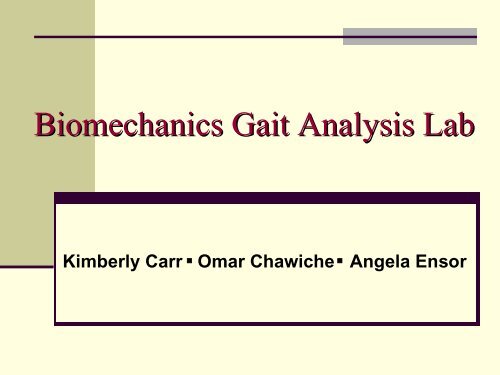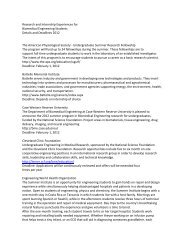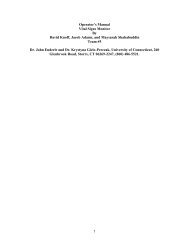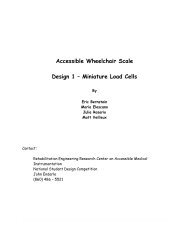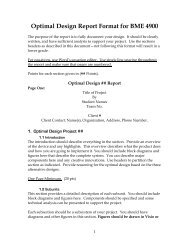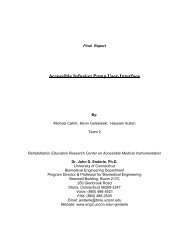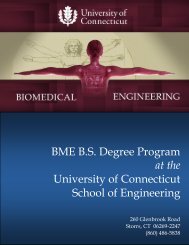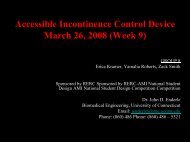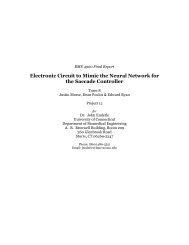Biomechanics Gait Analysis Lab - Biomedical Engineering ...
Biomechanics Gait Analysis Lab - Biomedical Engineering ...
Biomechanics Gait Analysis Lab - Biomedical Engineering ...
Create successful ePaper yourself
Turn your PDF publications into a flip-book with our unique Google optimized e-Paper software.
<strong>Biomechanics</strong> <strong>Gait</strong> <strong>Analysis</strong> <strong>Lab</strong><br />
Kimberly Carr Omar Chawiche<br />
Angela Ensor
Overview<br />
• Introduction<br />
‣ Clients<br />
‣ Project Objective<br />
‣ Previous Work<br />
‣ Patents<br />
• Optimal Design<br />
‣ Measuring Devices<br />
‣ Optical System<br />
‣ National Instruments Devices<br />
‣ Computer Program and Display<br />
• Budget<br />
• Timeline<br />
• Conclusion
Clients<br />
‣ Dr. John D. Enderle<br />
‣Program Director, <strong>Biomedical</strong> <strong>Engineering</strong>,<br />
University of Connecticut<br />
‣ David Kaputa<br />
‣<strong>Biomechanics</strong> <strong>Lab</strong>oratory Instructor
Project Objective<br />
Force Measurement System<br />
‣ Force Plate & Platform<br />
‣ Footswitches<br />
Optical System<br />
‣ Two Digital Video Cameras<br />
National Instruments Devices<br />
‣ Convert Analog Data to Digital (Force Measuring System)<br />
‣ Voltage Source for Force Measuring Device<br />
‣ Image Acquisition via S-video Cable from Two Video Cameras<br />
<strong>Lab</strong>VIEW® 8.0 & Vision Builder for Automated Inspection<br />
‣ Process and Display Digital Data from Force Measuring Systems<br />
‣ Process and Display Images from Two Video Cameras
Previous Work<br />
• Foot Pressure Device<br />
‣ Insoles<br />
• Dynamic Weight Transfer and Local<br />
Pressure Concentrations<br />
• Force Plates<br />
‣ Ground Reaction Forces<br />
‣ Vertical & Shear Forces<br />
‣ Center of Pressure<br />
• Motion Systems<br />
‣ Video Motion Systems<br />
• Measure joint angle and acceleration<br />
F-Scan® System<br />
www.tekscan.com<br />
4060-NC Force Plate<br />
Series www.bertec.com<br />
Peak Motus<br />
www.vicon.com
Patent Examples<br />
‣ 6,997,882 6-DOF subject-monitoring device and<br />
method –Parker, et al.<br />
• Methods & Devices Using Accelerometer<br />
‣ 4,631,676 Computerized video gait and motion<br />
analysis system and method –Pugh, James W.<br />
• Computerized Video & Motion System
Force Plates<br />
• A force plate is a device that measures the ground<br />
reaction forces exerted by a subject as they step on it<br />
during gait.<br />
‣ Top plate<br />
‣ Force transducers<br />
at each corner<br />
• Force plates allocate the measurement of both<br />
vertical and shear forces, as well as the center of<br />
pressure for the subject throughout gait using
Load Cells<br />
• Four Thames Side-Maywood 350a strain gauges/load<br />
cells that were previously purchased by the University<br />
• Strain gauge transducers employ<br />
four strain gauge elements<br />
electronically connected to form<br />
a Wheatstone bridge circuit
Force Plate & Platform Materials<br />
• The force plate and platform will be made out of a<br />
material that is relatively light weight, durable, strong,<br />
and cost-efficient.<br />
• Top Plate – 6061 Aluminum Alloy<br />
• Bottom Plate & Platform – 304L Stainless Steel<br />
Mechanical Properties of 6061 Aluminum Alloy<br />
Condition<br />
(Temper Designation)<br />
Tensile Strength<br />
(MPa)<br />
Yield Strength<br />
(MPa)<br />
Ductility<br />
(%EL in 50 mm)<br />
Heat Treated<br />
(T4)<br />
240 145 22-25<br />
Mechanical Properties of 304L Stainless Steel<br />
Tensile Strength (MPa)<br />
Compression Strength (MPa)<br />
Proof Stress 0.2% (MPa)<br />
Elongation A5 (%)<br />
Hardness Rockwell B<br />
500<br />
210<br />
200<br />
45<br />
92
2440 mm<br />
(96.06")<br />
508 mm<br />
(20")<br />
Top View<br />
840 mm<br />
(33.1")<br />
Platform<br />
464 mm<br />
(18.27")<br />
6061 Aluminum Alloy Top Plate<br />
25.4 mm<br />
508 mm<br />
(20")<br />
Side View<br />
Platform<br />
130 mm<br />
(5.12")<br />
25.4 mm<br />
(1")<br />
Load<br />
Cell<br />
6061 Aluminum Alloy Top Plate<br />
31.5 mm<br />
(1.24")<br />
Platform<br />
100 mm<br />
(3.94")<br />
2440 mm<br />
(96.06")<br />
25.4 mm<br />
(1")<br />
464 mm<br />
(18.27")<br />
Front View<br />
Platform<br />
25.4 mm<br />
(1”)<br />
Load Cell<br />
6061 Aluminum Top Plate<br />
Platform<br />
100 mm<br />
(3.94")<br />
840 mm<br />
(33.1")
Footswitches<br />
• Footswitches are a convenient and<br />
inexpensive way of obtaining temporal<br />
measurements during gait.<br />
• Typical measured parameters include:<br />
‣ Stance and swing times<br />
‣ Single limb support<br />
‣ <strong>Gait</strong> cycle duration<br />
• FSR switches are used to construct<br />
the footswitches<br />
‣ 2 layers of plastic w/printed<br />
circuit on inner surfaces<br />
‣ Applied pressure creates a switch<br />
closure resulting in a resistive<br />
electrical circuit<br />
‣ Resistance decreases as more<br />
pressure is applied resulting in a<br />
decrease in the voltage output
NI devices<br />
• PXI-1031:<br />
‣ Combine 4-slots PXI<br />
‣ Wide range of applications<br />
‣ Accept 3U PXI and compact PCI module<br />
• PXI-1411:<br />
‣ Color or monochrome acquisition<br />
‣ One external trigger/digital I/O line<br />
‣ Transfer rates up to 132 Mbytes
NI devices<br />
• SC-2345:<br />
‣ Signal conditioning for DAQ system<br />
‣ 16 analog inputs<br />
‣ Provide up to 300v<br />
• PXI-6040E:<br />
‣ Data acquisition device<br />
‣ Analog and digital triggering<br />
‣ 12 to 16 bit resolution
Optical system<br />
• Two digital video cameras (Sony Handycam<br />
DCR TRV27)<br />
‣Provide 3D image<br />
‣Instantaneous record of the markers movement<br />
‣Convert and record an analogue NTSC video source<br />
to digital video<br />
‣MPEG movie EX mode: in which it will allow us to<br />
record uninterrupted to the full capacity of the<br />
memory stick media
Computer Program & Display<br />
• Force Signal Processing<br />
‣ <strong>Lab</strong>VIEW® 8.0<br />
• Footswitch Signal Processing<br />
‣ <strong>Lab</strong>VIEW® 8.0<br />
• Optical System<br />
‣ <strong>Lab</strong>VIEW® 8.0<br />
‣ Vision Builder for Automated Inspection
3D Optical
Complete<br />
System<br />
Drawing
<strong>Lab</strong>oratory Layout<br />
482 in.<br />
Door w/ Frame (76 in. wide)<br />
Counter w/ Cabinets (254 in. X 34 in.)<br />
Sink<br />
109 in.<br />
Computer<br />
System<br />
National Instruments<br />
Devices<br />
Tensile<br />
Testing<br />
Machine<br />
48 in.<br />
Camera 1<br />
96 in.<br />
Camera 2<br />
147 in.<br />
Desk (34 in. depth)<br />
Table (144 in. X 60 in.)<br />
132 in.<br />
424 in.<br />
65.5 in.<br />
Walking Path 96 in. Length<br />
Russell Traction Set-up<br />
(111 in. X 36 in.)<br />
White Screen<br />
Table (144 in. X 60 in.)<br />
Table (144 in. X 60 in.)<br />
Table<br />
Heater<br />
Table
Budget
Timeline<br />
• Initial meeting (week one)<br />
• Optical system tested and completed by week six<br />
• Force measurement system completed by week<br />
twelve<br />
• <strong>Lab</strong> view program completed in conjunction with<br />
device testing and completion dates<br />
• Combine and test entire project by week thirteen<br />
• Complete final lab report by week fourteen<br />
• Demonstration and presentation in week fifteen
Conclusion<br />
<strong>Gait</strong> <strong>Analysis</strong> <strong>Lab</strong>oratory<br />
• Incorporate a hands-on approach to gait analysis through<br />
the use of an integrated:<br />
‣ Force Plate & Platform<br />
‣ Footswitches<br />
‣ 2 Digital Camcorders<br />
‣ National Instruments Equipment<br />
‣ Interactive National Instruments <strong>Lab</strong>VIEW® Software Program<br />
• Students will gain a deeper understanding of gait analysis<br />
through the use of 2 different types of measuring devices<br />
that are not currently available in the <strong>Biomechanics</strong> lab.<br />
• Design fulfills the upgrade request for the <strong>Biomechanics</strong><br />
gait analysis lab in providing a more robust example of<br />
biomechanics applications and bridging the gap between<br />
the classroom experience and clinical applications.
Acknowledgements<br />
• University of Connecticut<br />
‣ Dr. John D. Enderle, Client and Advisor<br />
‣ David Kaputa, Client and Advisor<br />
‣ Christopher Liebler, Advisor<br />
• National Instruments<br />
‣ Bharat Sandhu, Field Engineer
Questions ?


